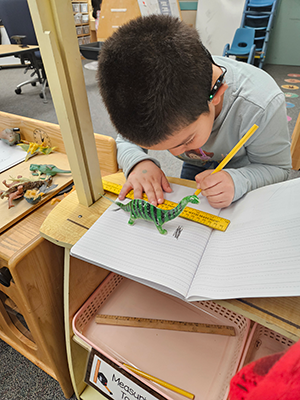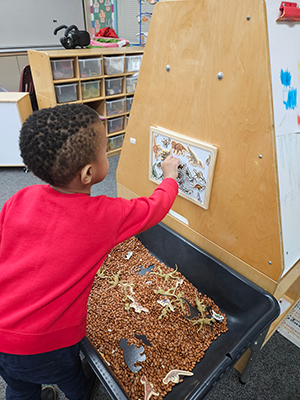To most preschool students, words like “pupa”, “chrysalis” and “metamorphosis” are heard for the very first time during early science lessons about how a caterpillar becomes a butterfly.
 But, what if students were not able to hear those words?
But, what if students were not able to hear those words?
What if there wasn’t a direct way to “say” those words for Deaf/Hard of Hearing preschool students who are learning American Sign Language and complicated science terms at the same time?
This is one of several challenges that RCOE Deaf/Hard of Hearing (DHH) preschool teacher, Darrian Briggs is working to overcome in order to instill a love of science for students in her Riverside County Office of Education classroom that is located at Palms Elementary School in the Perris Elementary School District.
In addition to the lessons that most preschoolers have as their first organized classroom experience, Mrs. Briggs is also teaching her students American Sign Language.
“For our students who are deaf, being in school is often the first time they’re being exposed to accessible language. They are learning their first words in our classroom by learning how to sign and put together sentences,” Mrs. Briggs said. “You can really see the magic that language can give to them. It is powerful because it gives them opportunities that they might not have at home as some have been sheltered and confined to a world without a way to communicate effectively with others.”
American Sign Language is what is known as a visual language that can contribute to understanding by showing—like telling a story. However, many technical terms like “pupa” and “chrysalis” don’t have direct signs in American Sign Language.
 Instead, “iconic signs” are used, which show what things look like to represent the sign, like using one’s arm as a tree, or using fingers to act out the movements of a caterpillar spinning itself into a chrysalis. This is a popular strategy to break down complicated topics like the metamorphosis process into accessible language that can challenge students to comprehend new concepts visually while expanding vocabulary.
Instead, “iconic signs” are used, which show what things look like to represent the sign, like using one’s arm as a tree, or using fingers to act out the movements of a caterpillar spinning itself into a chrysalis. This is a popular strategy to break down complicated topics like the metamorphosis process into accessible language that can challenge students to comprehend new concepts visually while expanding vocabulary.
“For lots of kids, you can do science on the smartboard. But, with students who are deaf, you really have to bring that hands-on learning to their level in the classroom to bring it to life and encourage their creativity and learning with a sensory aspect,” Mrs. Briggs said. “I want to give them opportunities to do things that they’ve never done before and experience the world in ways that are accessible them.”
Mrs. Briggs took action to bring more hands-on science materials for her DHH preschool students so that the wonders of science and their world could come alive in ways that they could experience it.
Each year, the Riverside County Board of Education (RCBE) invites RCOE staff to apply for a Unique Project Grant to promote the creation of innovative programs that break new ground in enhancing and expanding organizational programs and services.

Mrs. Briggs’ proposal, “Little Hands, Big Science” included bringing DHH-friendly science materials into her classroom. Her submission was approved for $1,000 and new science materials have started arriving in her classroom.
Students in Mrs. Briggs’s class are now exploring concepts on their own using magnifying classes, binoculars, specimen samples, and other science kits that recruit their sharpened senses. Initial kits have included learning materials about dinosaurs, reptiles, honeycombs, insects, and resin-based samples.
“I want to grow their curiosity at the age of 3 and 4, so that by the time they are older, it is part of who they are,” Mrs. Briggs said. “I’ve seen the impact of hearing loss, and I know that the Deaf community is so rich. It makes me feel special to be a part of fostering that early on with my kids.”